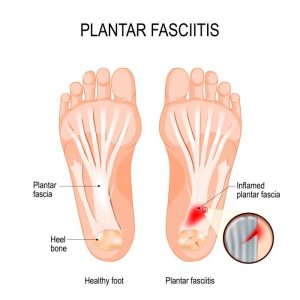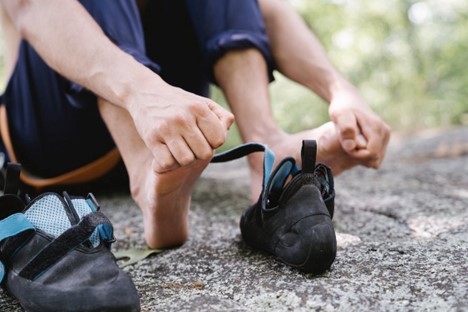Running is a blood-pumping, liberating, and exhilarating workout, but it can be challenging for those with plantar fasciitis. The condition is one of the most common causes of heel pain that involves inflammation of a thick tissue band that runs throughout the bottom of both feet and connects the toes to the heel bone.
Plantar fasciitis generally causes sharp stabbing pain, especially when taking the first steps in the morning. With continued walking, the pain decreases but can return during long periods of standing up after sitting or standing. While the leading cause of plantar fasciitis is unknown, it is commonly prevalent in overweight people and runners.
If you are a plantar fasciitis runner, you understand the pain and discomfort when hitting the pavement or even getting out of bed. Though it is essential to get plenty of rest, many runners wonder if they should continue running when dealing with this type of heel pain.
Experts suggest that it is okay to continue running with minor to moderate cases of plantar fasciitis in the short term. However, it is crucial to rehabilitate the lower extremity, or you risk worsening the condition. With mild plantar fasciitis, pain is usually felt at the start of the workout, but fades away as you continue to run. In such a case, the discomfort is caused by muscle tightness, and this can be tackled with exercises that improve ankle mobility and hip strength and reduce calf tightness.
But this is not the time to increase the intensity and volume of your runs. If you experience consistent pain before and after the run, immediately stop. If you continue to run in such situations, you may cause severe damage to the tissue, develop irregular movement patterns, increase inflammation, or increase the risk of sustaining injuries.
Best Tips for Running with Plantar Fasciitis
Plantar fasciitis is one of the most common foot problems in runners. If you have a case of mild plantar fasciitis and wish to continue your training, here is a list of things you should be doing to not worsen the pain.
Support your Feet

One of the best ways to give your feet support is through the right shoes that provide arch support and will prevent your plantar fasciitis from further aggravating. Taping is another way to manage the pain caused by this condition. This involves wearing special tape around your ankle and foot. Doing so will help stabilize the bone and offer support to the arch of your foot.
You can find an array of tape for plantar fasciitis on Amazon in different colors, widths, and lengths, such as this PFT Tape. Pharmacies and sports goods stores also carry a range of tape options to choose from. If you are unsure about the best way to use this tape, you can take the help of an athletic trainer, a physical therapist, or a healthcare professional who can properly guide you.
Regular Stretching Exercises
Doing stretching exercises involving your calf, ankle, and plantar fascia daily a few times a day can keep you running. If you are experiencing controlled symptoms and backing that up with a regular stretching routine, you can continue to run at intervals.
Do a Proper Warm-up
As a plantar fasciitis runner, you should spend a minimum of 5 minutes doing warm-ups before you begin any kind of physical activity. Before running, focus on dynamic stretches that activate your calves, glutes, hip flexors, quads, and hamstrings. Once warmed up, spend a little time stretching your feet, paying special attention to the arch area and heel.
Incorporate Cross-Training into your Routine
Adding cross-training exercises to your routine can help you immensely if you are planning to return to running or trying to recover from severe symptoms. It is essential to monitor the intensity and volume of your training, and you should avoid increasing your frequency and mileage by over 10% each week. Increasing the training too much can trigger inflammation and cause injuries.
Ice the affected area
Once you are done with the stretches or any other physical activity, don’t forget to apply ice on the plantar fascia for at least 10 to 15 minutes. Wrap the ice in a thin cloth or use ice packs to apply on the affected area. You can also try the ice bottle massage, where you use a bottle with frozen water, place it under your foot and roll it back and forth with moderate pressure for around 5 to 10 minutes.
When Should You Stop Running?
You should take generous breaks from running or even walking exercises if you struggle with plantar fasciitis. If you experience pain after the initial pain subsides, you can try cross-training to control the symptoms. Good low-impact options include swimming, rowing, or elliptical biking.
If the pain improves sufficiently, you can slowly ease back into your running routine. Start slow with a walk-jog and see how your body responds to it. If the pain returns, you are probably not ready to start running again.
It is always better to take a few weeks off to properly address your physical issues rather than rushing into it and risking an injury that might prevent you from running for longer.
Wrap up
No one-size-fits-all solution for plantar fasciitis will apply to all runners. For this reason, it is best to seek professional assistance from a physical therapist or doctor who can properly assess the condition. They can also recommend the best solutions.
Having a suitable exercise regime along with proper shoe wear can help control the symptoms to a great extent. Moreover, you can buy a device called a night splint that is worn at night and will help stretch your plantar fascia and Achilles tendon while you sleep. The aim is to minimize pain in the morning.
In addition to the precautionary measures you take, you should closely examine the severity of the condition. If you are experiencing mild symptoms, you can likely continue running, but if the pain is severe, indulging in intensive workouts or frequent runs is not advised.
[wpchatai]


